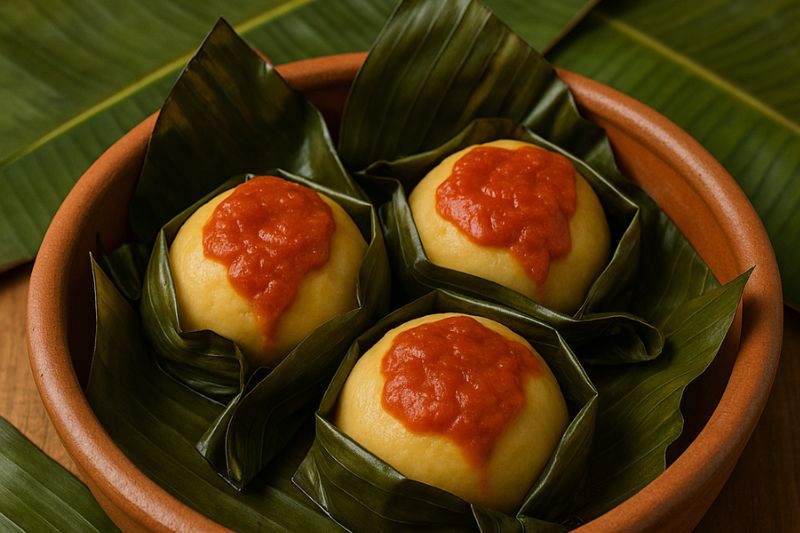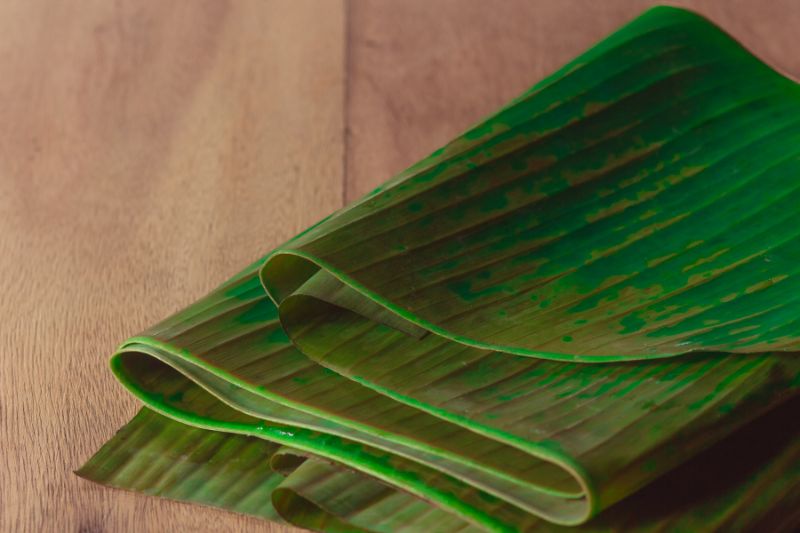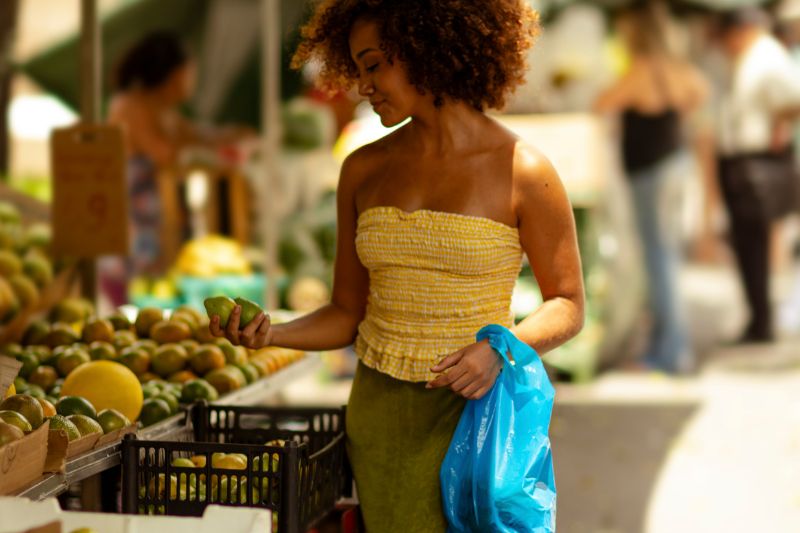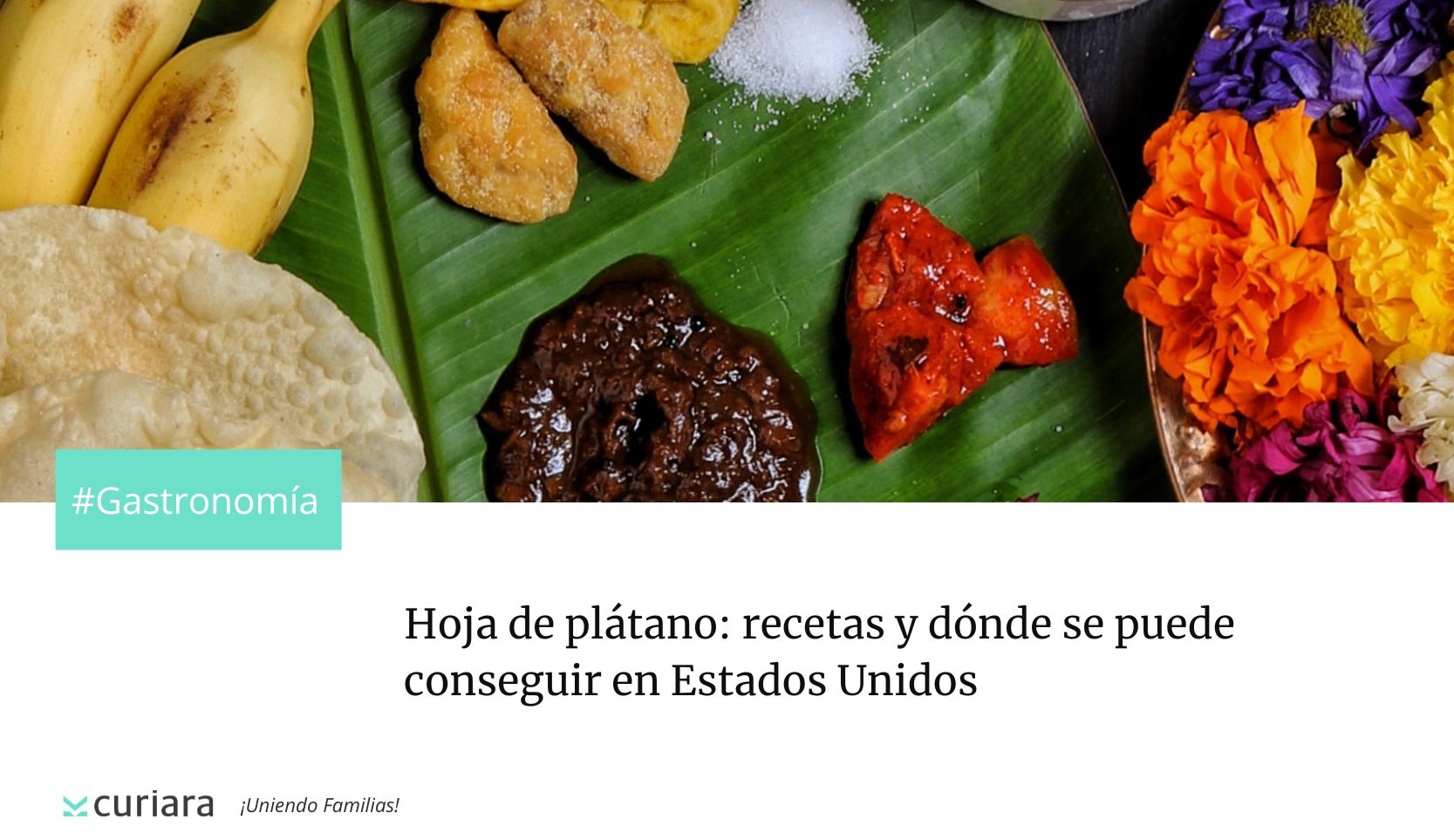For those of us who have had to leave our homeland, speaking of the banana leaf is to talk about home. Of the flavors that wrapped us in December, of the hands of our grandmothers folding with care each hallaca, of the stoves lit early in the morning and of the whole family gathered around a pot.
The banana leaf is not just an ingredient, it is a direct link with our traditions, with Venezuela.
In this guide, we will explore everything about the banana leaffrom its culinary importance, to where it can be obtained at United States. We will share recipes where it is the clear protagonist, and how to preserve that part of our identity, even if we are far away.
Because when we prepare a hallaca, a bollito or a wrapped cachapa, we are celebrating our culture.
The symbolic and gastronomic value of banana leaves

The banana leaf at Venezuela has a profound gastronomic as well as symbolic value. Its use dates back to the indigenous and African traditionss, and it continues to be an essential element of the Venezuelan cuisineespecially in family celebrations and festivities.
The banana leaf not only envelops food, but also adds a unique, smoky and unmistakable flavor that enriches dishes such as hallacas, scones, tamales and other typical delicacies.
A fundamental gastronomic element
The banana leaf is essential for the preparation of the hallacasthe quintessential Christmas dish, and others, such as traditional foods. Its ability to steam the ingredients and give them a special flavor is a fundamental part of these dishes.
In addition, its use helps to maintain the moisture and freshness of the food, making the flavor unique and delicious.
A symbol of family unity
Beyond its culinary function, the banana leaf symbolizes the family unity. During the preparation of traditional dishesgenerations gather to wrap and cook together, which strengthens family ties and transmits the love of tradition. In every bite, the history and identity of Venezuela.
The banana leaf not only represents one more ingredient in the kitchen, but it is a link to our heritage and a reflection of our culture and values. It is the soul of Venezuelan gastronomy.
Traditional use of banana leaf in Venezuelan recipes

In our kitchens, the banana leaf has been a protagonist for generations:
- HallacasOne of the most typical dishes of Venezuelan gastronomy and a must for Christmas, the hallacas are prepared by wrapping corn dough stuffed with a succulent stew in banana leaf.
- Bollitos: Small corn masa delights wrapped in banana leafsometimes with meat, cheese or simply corn filling.
- Venezuelan Tamales: More creamy, usually with a wetter dough, also wrapped in banana leaf.
- Sweet wrappersAs the "bollitos de papelón"sweet, soft and flavored.
Venezuelan recipes with banana leaves
Below you will find some of the venezuelan recipes with banana leaves essential of our gastronomy:
Traditional Hallacas

Ingredients:
- 1 kg of precooked corn dough
- 500 g beef
- 500 g of pork
- 500 g chicken
- 2 large onions
- 1 red pepper
- 100 g capers
- 100 g green olives
- Raisins to taste
- Sweet wine
- Salt, pepper, cumin
- Onoto (annatto) in oil
- Banana leaves cleaned and heat-treated
- Tying wick
Preparation:
- In a large pot, heat onoto oil and sauté chopped onion and paprika. Add the chopped meats (beef, pork and chicken) and cook until seared. Add wine, capers, chopped olives and raisins. Simmer until the stew thickens and the flavors are well integrated. Allow to cool.
- Kneads the precooked corn flour with water, salt and onoto oil until a smooth, hydrated and bright yellow dough is obtained.
- On a banana leaf previously cleaned and cooked, place a portion of dough, flatten it and add a spoonful of stew in the center. You can decorate with paprika strips, onion wheels or olives.
- Carefully fold, forming tightly closed packages, and tie with wick.
- Boil the hallacas in plenty of salted water for approximately one hour. Then remove, drain and let stand before serving.
Each hallaca represents a little piece of our land that is preserved in the memory and heart.
Bollitos pelones

Ingredients:
- 500 g of precooked corn dough
- 300 g ground beef
- 1 small onion
- 2 cloves garlic
- Salt, cumin and pepper to taste
- Banana leaves clean
- Wick
Preparation:
- In a frying pan, heat a little oil and sauté the chopped onion together with the crushed garlic. Add the ground beef and cook over medium heat, stirring to break up any lumps. Season with salt, pepper and seasonings of your choice. Cook until the meat is well browned and juicy. Remove from heat and let cool.
- Prepare a soft dough using corn flour water and salt. Knead until it is uniform and manageable, neither too dry nor too sticky. Take a portion of dough and form a ball the size of a large walnut.
- Make a hole in the center with your finger, place a teaspoon of the meat stew inside and close carefully, making sure that the meat is completely covered by the dough. Round the dumpling again between the palms of your hands.
- Wrap each bollito on a piece of banana leaf flexible (cleaned and previously heated) and fold the ends tightly. Tie each package with wick
- Boil plenty of water with a pinch of salt in a large pot. Place the scones wrapped in boiling water and cook for about 45 minutes. Once ready, drain and let stand for a few minutes before serving.
Tamales barineses

Ingredients:
- 700 g of corn dough
- 400 g shredded chicken
- 200 g of pork in strips
- 1 red onion
- 1 green bell pepper
- Salt and pepper
- Onoto oil
- Banana leaves
Preparation:
- In a large skillet, sauté chopped onion and paprika in a little oil. Add the chicken and pork cut into small pieces and cook over medium heat until well cooked and browned.
- Season with salt, pepper and, if desired, a touch of cumin or adobo. Cook until the flavors blend well and the stew is juicy but not too runny. Allow to cool.
- In a large bowl, knead the precooked corn flour with warm water, salt to taste and enough onoto oil to give the dough a soft yellow color and a smooth, manageable texture.
- Place a banana leaf previously cleaned and heat-treated on the table. Take a portion of dough and roll it out into a circle. Add a generous spoonful of the stew in the center.
- Then, carefully fold the sheet, closing the tamale compactly, and secure the edges by folding or wrapping if necessary.
- Place the tamales in a pot with a steamer or in a colander over boiling water, making sure they do not touch the water directly. Steam for about an hour, making sure there is always enough water to generate steam.
Once ready, let them rest for a few minutes before serving.
Tamales barineses are a warm embrace, perfect for sharing with the family.
Tips for proper handling and storage

The proper use of the banana leaf is fundamental to achieve successful traditional preparations, both in presentation and flavor. Here is a detailed guide on how to clean, prepare and preserve it properly:
- CleaningBefore use, clean the banana leaf Afterwards, it is advisable to pass it briefly through the heat in a hot pan, without leaving it too long. This exposure to heat makes the blade more flexible, making it more manageable and less likely to break during use.
- Cut: Remove the central ribbing (the thickest vein that runs longitudinally through the center) if it is very thick. It is advisable to remove it carefully using a knife or scissors, to avoid making it difficult to handle the blade when wrapping.
- StorageChill in the refrigerator wrapped in plastic or damp cloth to maintain freshness, or freeze for later use.
The good handling of the banana leaf is key so that the dishes do not break and retain their traditional flavor.
Where to get banana leaf in the United States

Although it might seem a difficult ingredient to find outside of the Latin Americathe banana leaf is available in numerous locations throughout the United States, as long as you know where to look.
This essential product for preparing traditional dishescan be found in different trading options:
Latin supermarkets:
One of the most accessible ways to get banana leaf is by visiting supermarkets that cater to Hispanic communities. Large chains such as Sedano's, Bravo Supermarkets, Fiesta Mart, The Super and other Latin-focused supermarkets often offer it, especially during holiday seasons such as Christmas or Day of the Dead.
In addition, local Mexican supermarkets, even the smallest or neighborhood ones, often have fresh banana leaves or frozen in your fresh produce section or in special freezers.
Asian stores:
Another excellent alternative is Asian grocery stores. Chains such as H Mart, 99 Ranch Market and other markets for Southeast Asian products such as Filipino or Thai products often have banana leavesThey are also common ingredients in their traditional cuisine.
It is possible to find the fresh leavesThe products are usually refrigerated or frozen, usually packaged and ready for culinary use.
Local agricultural markets:
In several states of United States with warmer climates or with a strong presence of Latin American communities, farmers markets are also a fantastic place to find banana leaves.
States such as Florida, Texas, California and New York stand out in this regard. During peak production seasons, some growers even sell freshly harvested leaves.
Online stores:
For those who prefer the convenience of shopping from home, online stores offer a practical solution. Portals such as Amazon, eBay and sites that specialize in Latin or international products offer frozen banana leavesin different presentations and sizes.
It is only important to verify that the product is well packaged and comes from a reliable supplier to ensure quality and freshness.
Enjoy!
Once we managed to find banana leafis a reason to rejoice! With it, in our hands, we have the way free to revive and share our culinary traditions, proudly preparing our hallacas, bollitos, tamales and other emblematic dishes that connect us with our roots and family memories.
At CuriaraWe hope to have taken you back to those beautiful memories of family reunions, homemade flavors and celebrations full of love, helping you to keep the tradition and warmth of our home alive, wherever you are.
